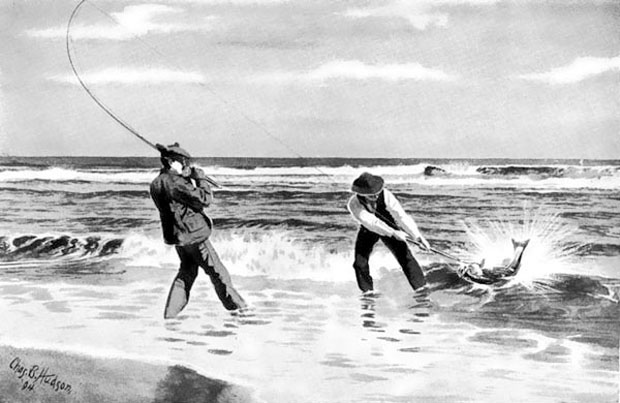Historic Fish Stories
07 Jul 2016
A smite on the angler's thrill of a good catch and the subsequent fish tales
By SUZANNAH SMITH MILES

“If fish keep nibbling at bait, they must expect, at last to get a hook in their gills,” wrote Charleston historian Dr. John Beaufain Irving in 1850, describing a fishing excursion in waters near Sullivan's Island. Irving (1800-1881) was a rice planter, medical doctor, horse racing enthusiast and best known as the author of A Day on Cooper River, published in 1842.
Irving was perhaps a better storyteller than true fisherman. Otherwise he would have known that a fish takes the hook in its mouth, not its gills. Yet like other noted Charleston writers through the ages, he obviously enjoyed the thrill of the catch.
“Bless me! What a bite – jerked is the line – why, what a voracious rascal!” wrote Irving, surprised to find the catch was a shark. “'I have him,' says another of our crew, and sure enough with better luck, he drags him to the surface – how he resists with determined energy every effort made to haul him out of the water. His fins are busily at work with immense power, beating the water by his side like the paddles of a small steamer, but he is finely hooked, and he cannot tear himself loose. With one tremendous flirt, however, just as he is about to be dragged into the boat, he severs the line as if it was a cambrick thread, breaks away, and disappears from our sight, soon to sport again in the depths of his native element!”
Since time immemorial, anglers have exhilarated over the joy of bringing in the “big one.” Indeed, there are so many fish in our Lowcountry seas that the big one could be just about anything – a shark, spot-tail bass, sheepshead, trout, bull whiting, black drum or tarpon. It doesn’t matter if one is surf fishing from a beach, trolling the harbor or fishing in a creek from a boat, there’s always an element of surprise when it comes to what you might catch. It is part of the thrill and the catch is usually worth talking about later—or a good excuse for why the big one got away. Some of the stories are wonderful, particularly when told by some of the best writers the Lowcountry has produced.
“The spring was late, but, in spite of the unseasonable chill, the sharks had arrived on time,” wrote the brilliant Charleston author Herbert Ravenel Sass in 1920, for a piece on fishing for Harper’s Monthly Magazine. Sass (1884-1958) was a naturalist, historian and writer, perhaps best known for his novel Look Back To Glory, published in 1933, and for writing the “Woods and Waters” column for the News & Courier. In the piece for Harper’s, Sass was describing surf fishing for channel bass (also known as red fish or spot-tail bass) at Frampton’s Inlet near Edisto. Instead of bass, he found sharks.
“He was a big fellow,” wrote Sass, “some ten feet long, I judged, basing my estimate on the distance between his dorsal fin and his tail fin, both of which projected well above the surface as he swam slowly along through the white, foam-covered water just inside the reef… I had been wondering whether it might not be possible at dead low water to wade the slew and fish for half an hour at least in the breakers on the seaward side of the bar. But any plan of the sort that might have been forming in my mind dissolved instantly when I saw that shark sculling along the edge of the submerged reef, not six feet from where I should be standing in the water.”
Sass and his companions smartly decided to stay put, watching sharks of varying sizes swim by with “their tall black dorsal fins reminding us of the periscopes of submarines; and we amused ourselves by trying to cast our lines on the back of one monster as he passed slowly by at a distance of twenty-five or thirty yards. Of course, we caught no bass. Where big sharks are so plentiful no prudent bass can be expected to linger.” Sass had a fine excuse for coming home empty-handed on that fishing trip.
The Mosquito Fleet
Some of the most intrepid fishermen in Charleston’s history were the Gullah watermen who were members of what was fondly known as the Mosquito Fleet. From the 1860s until the 1950s, their small boats were a familiar sight as they sailed out to sea each morning and returned each afternoon with their catch. They would often go as far out as 30 miles to catch porgy, bass, whiting and, if lucky, a “jack fish.” They were said to be as steady as St. Michael’s chimes and one could set a watch by their morning run out. When they came in, their sails formed a picturesque line that stretched all the way to the horizon.
In his novel Porgy, which was later transformed into the opera “Porgy and Bess,” Dubose Heyward (1895-1940) described the fleet in picturesque detail.
“Out at the harbor mouth, against the thin greenish-blue of the horizon, appeared the Mosquito Fleet. Driven by a steady breeze, the boats swept toward the city with astonishing rapidity. Warm sunlight flooded out of the west, touched the old city with transient glory, then cascaded over the tossing surface of the bay to paint the taut, cupped sails salmon pink, as the fleet drove forward directly into the eye of the sun.”
Consummate sailors, the men of the Mosquito Fleet carried no navigational aids of any kind, not a chart or a compass. They weren’t needed. The skippers had an instinctive dead reckoning that even the harbor pilots regarded as “uncanny,” and knew their position even when they were out of sight of land.
In 1928, a News & Courier reporter accompanied the fleet on their daily trip to the offshore fishing banks. “I asked them how they remembered the exact positions of these shallows so many miles outside of the harbor,” he wrote, “and the skipper replied that he could fish within fifty yards of the same spot every day if he wished to do so.”
After a day of fishing they would return to the docks on Charleston’s waterfront. Wrote Heyward, “Afternoon found the wharf crowded with women and children, who laughed and joked each other as to the respective merits of their men the luck of the boats in which they went to sea.
“Indeed the catch was so heavy that as boat after boat docked, it became evident that the market was glutted, and the fishermen vied with each other in giving away their surplus cargo, so that they would not have to throw it overboard.“
This was in the days when Charleston was a sleepy holdover of the 19th century. Even as late as the 1950s the fish the Mosquito Fleet brought in were sold door-to-door by street vendors pushing wooden carts. The “fish man” would sing loudly about his catch as he slowly pushed his cart down the narrow Charleston streets.
“Fish, fish, fish,” the singer would cry. “Oh, de porgy walk, and de porgy talk, De porgy eat with a knife and fork. Porgy, Porgy! Fre-e-esh fish!”
William Elliott’s Devil-Fish
The writer who probably heads the list of all-time tellers of fish stories is William Elliott (1788-1863), a successful politician, planter, sportsman and author of Carolina Sports by Land and Water, published in 1846. The book describes Elliott’s adventures hunting bear, deer and wildcats, as well as fishing for drum, sheepshead, bass and the elusive “devil fish,” the giant manta ray once prevalent in lowcountry waters.
“Imagine,” says Elliott in his book, “a monster measuring from sixteen to twenty feet across the back, full three feet in depth, having powerful yet flexible flaps or wings, with which he drives himself furiously through the water or vaults high into air; his feelers (commonly called horns) projecting several feet beyond his mouth and paddling all the small fry, that constitute his food, into that enormous receiver—and you have an idea, an imperfect one, of this curious fish, which, annually during the summer months, frequents our southern seacoast.”
Herbert Ravenel Sass also wrote about the devil fish. “Standing one day on the high sea wall of the Battery, in Charleston, and looking out across the wide harbor toward Fort Sumter, I saw a thing so weird and fantastic that at first I doubted my own eyes. I saw a monstrous winged creature, like a gigantic bat, shoot up out of the water and then fall back again. It was visible only for an instant; and keeping my eyes fixed upon the spot where it had disappeared, I asked myself whether I had seen anything real or whether the sunlight on the water had produced an extraordinary illusion.”
In a segment entitled “Fishing Extraordinary,” Elliott delights the reader with one of the great fish stories of all time, an Ahab-and-the-great-white-whale tale of a man named Jones who had harpooned a devil fish which then proceeded to drag him and his boat around the bay at Beaufort with thrilling speed, much to the amazement of on-lookers onshore.
“There is much that is pleasant in the excitation of violent motion!” wrote Elliott about Jones as, after he had harpooned the devil fish, was being pulled around the bay with the speed of an arrow. “The wind fanned his face, his hair streamed off at right angles from his head, the water foamed furiously about the stem…”
“And now he approached his home, and he rejoiced to see that several of his friends were assembled on the bluff to welcome his return. But what was their amazement, to behold and recognize Jones, seated upright in the stern of his boat, which seemed to fly through the waters without the aid of oar, oarsmen, sail or steam, or any apparent or visible impulsion. ”
“Amazement was their first emotion – joy was their second – and they shouted forth in triumph as the thought suddenly flashed upon them, Jones had discovered perpetual motion!! He shouted to them for assistance: 'Man me a boat, my friends, hasten to my rescue.' His voice...drowned by distance, never reached their ears. He waved his hat, and shouted again; hats waved in return, and a triumphant shout responded from his friends – but no boat put off, no rescue came!”
The fish eventually pulled Jones, "quite out of the harbor… and into the waters of the wide Atlantic,” where Jones finally had the sense to cut the line and let the devil fish go. His oars having been lost in the melee, Jones fortunately had a sail on board and set it for home, “but it was late at night when he arrived, exhausted by excitement and fatigue, and explained to his anxious friends the mystery of his… perpetual motion!”
Ah, fish stories! Today, boats get their speed from motors, not a New England sleigh-ride from a justifiably angry devil fish. One thing hasn't changed. That is the exhilaration which comes with feeling that first hit at the end of your line and the electrifying thrill of watching your pole bend tight as a big fish makes its initial run. If history is any guide, it never will.
Spot-tail Bass
Anglers call this popular saltwater fish by many names – channel bass, drum, puppy drum or redfish for the copper color of its scales. Here in the Lowcountry we know it as a spot-tail for the distinctive black spot on its tail. Its scientific name is Sciaenops ocellatus, which very loosely translates to “fish with an eye spot.” Apparently the natural coloration fools predators into attacking the tail rather than the head, giving the fish a better chance of escape. Sometimes the fish will have more than one spot on its tail. Rarely, it has no spot at all.
The spot-tail is the Lowcountry inshore fisherman’s most popular gamefish. They are great fighters and can grow to mammoth sizes. The South Carolina record is a 75-pound behemoth caught in 1965.
In 1933, angler Robert S. Barnwell, Jr. offered even more colloquial names for the spot-tail. “In Virginia the bass is called red drum; in Florida redfish; in South Carolina simply bass. We divide them into three classes according to size – school-bass, stag-bass and channel-bass – we fish for school-bass in the creeks, for stag-bass in the surf, and channel-bass in the rips of harbor banks. As a rule, stag or surf bass range from 20-22 inches, while the school bass are below 16" and the channel bass above 36".
Herbert Ravenel Sass wrote in his “Woods and Waters” newspaper column, “Here, we call it channel bass and the smaller specimens the school bass. Sometimes it is termed spot, though this name rightfully belongs to another species. In Florida it is known as red-fish, or sometimes red-horse and proceeding along the gulf coast to Louisiana, we find it as the ‘poisson rouge’ of the Creoles. Perhaps if called ‘Southern red-fish’ it would be acceptable to the majority of anglers and fit the fish all around much better than some of its many names of today. Whatever one calls it, however, there is no doubt about its popularity among fishermen. Reaching a great size at times, it is a fine fish for sport, and though the larger ones are somewhat coarse on the table, a ‘school bass’ is a dish fit for a king.”











